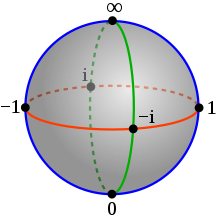
Back كرة ريمان Arabic Esfera de Riemann AST Риман сфераһы Bashkir Esfera de Riemann Catalan Riemannova sféra Czech Riemannsche Zahlenkugel German Σφαίρα του Ρίμαν Greek Rimana sfero Esperanto Esfera de Riemann Spanish Riemannen esfera Basque


In mathematics, the Riemann sphere, named after Bernhard Riemann, [1] is a model of the extended complex plane (also called the closed complex plane): the complex plane plus one point at infinity. This extended plane represents the extended complex numbers, that is, the complex numbers plus a value for infinity. With the Riemann model, the point is near to very large numbers, just as the point is near to very small numbers.
The extended complex numbers are useful in complex analysis because they allow for division by zero in some circumstances, in a way that makes expressions such as well-behaved. For example, any rational function on the complex plane can be extended to a holomorphic function on the Riemann sphere, with the poles of the rational function mapping to infinity. More generally, any meromorphic function can be thought of as a holomorphic function whose codomain is the Riemann sphere.
In geometry, the Riemann sphere is the prototypical example of a Riemann surface, and is one of the simplest complex manifolds. In projective geometry, the sphere is an example of a complex projective space and can be thought of as the complex projective line , the projective space of all complex lines in . As with any compact Riemann surface, the sphere may also be viewed as a projective algebraic curve, making it a fundamental example in algebraic geometry. It also finds utility in other disciplines that depend on analysis and geometry, such as the Bloch sphere of quantum mechanics and in other branches of physics.









